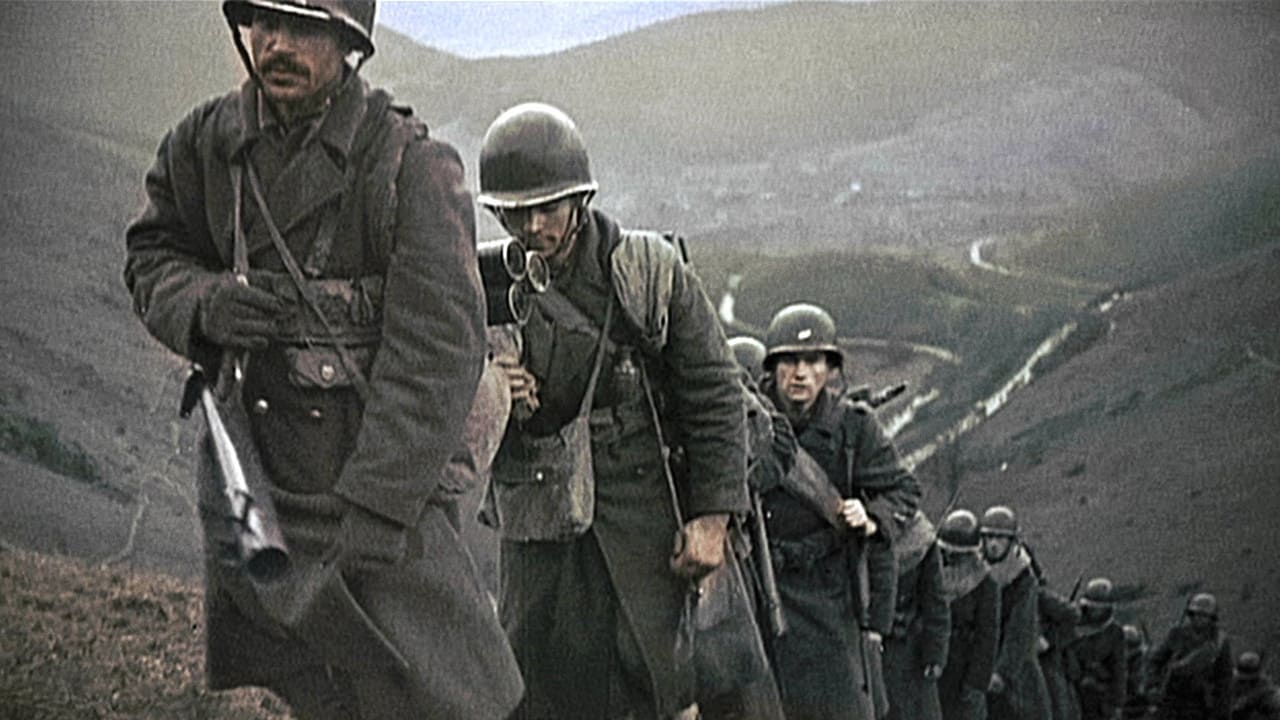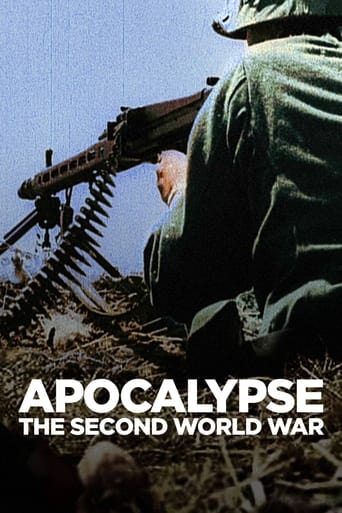

This series followed "Apocalypse: Hitler", and explains with sometimes very crude and brutal images, the events of World War II.Narrated by Mathieu Kassovitz in French, it truly brings the war up to its exploits and its horrors. Some excerpts were shot by American directors John Ford and John Huston, right on the spot.Thus maybe one flaw was the fact that it showed mostly the war on the European front, Hitler's wanting to rule the world, the Soviets fighting back with strong forces. Only the fourth episode shows the Pacific War with the Japanese using "Bushido" to stand up to its enemies, mostly the Americans. It took atomic bombs to end it all...And in Europe, the crush on three sides: the Normandy Raid, the African defeats and the Soviet eastern push did end Nazi Germany and Fascist Italy dominations.This is a documentary not to be missed. Warning: some images can be disturbing...
... View MoreA coloured version of events was needed to draw in viewers. A rewriting of history if ever there was one. It is, on close inspection, a propaganda odd job (in this case from France). The quality is poor because the black & white film was crudely coloured. So the film is dominated by red, green and grey. The historical information is misleading, erroneous and terribly one-sided. This is a documentary for the West and, most of all, for the NEW EUROPE. The information is lame. Yes, lame. So much time is spent on misleading and erroneous bits of information that the viewer won't understand what the war was about. This is not a quality analysis, but another piece for Western propagandists. Europe joined under fascism before. I guess it's not surprising that Europe has joined under something similar again. The odd man out is once again Russia. In the United States this "documentary" was shown on conservative propaganda channels like National Geographic (owned by media mogul Rupert Murdoch). The English dub sounds pathetic. It sounded like the narrator was joking instead of providing a serious performance. The score by Kenji Kawai is catchy, but it's suited for a pompous TV show and not for a documentary about World War II. The documentary's title isn't even suitable. The word 'apocalypse' can only describe the Eastern Front in World War II. The Eastern war was epic. But it's here that the documentary is obviously revealed to be propaganda and a rewriting of history. If someone tries to argue about World War II using "facts" from this documentary then someone like me, who has read plenty about 20th century history, can easily reveal that that person is an amateur. A campaign of rewriting history is under way in the West. Nasty books, movies and documentaries are being released. The enemy is, as always, the Russian bear and its Communism. This is propaganda for the new more imperialist and more authoritarian Europe and America (America's contribution and her war against Japan are also simplified and distorted).All sorts of methods are used to falsify Russia's history. So, Adolf Hitler can't be portrayed in a bad way in this type of propaganda because he did invade Soviet Russia - the focus of Western propaganda for the last century. No, his successes in war and in politics have to be mentioned and exploited. Well, Hitler's policies resulted in the deaths of over 30 million people all over Europe but this can't be mentioned. I will, however, point out that Hitler was financed and put in power by Western oligarchs and by the British, and he carried out the plans of the globalist Western elites. I'm not a hater of the Germans and I don't think that the Germans are fully responsible for the genocide because the Nazis carried out these brutal policies mostly in the interests of the Western oligarchy (the monopoly capitalists and the financial capitalists). So the Germans shouldn't be blamed because the people who are really at fault are the oligarchs and the British. The Germans were victims of finance capital almost as much as the Russians. But you're not going to hear this information in this series. Hitler wasn't the completely crazy man that he's being portrayed as nowadays. The British were the ones who tricked the Germans into attacking the Soviet Union. It's not much different from how they tricked the Germans before World War I. After Hitler invaded Russia, and after he found out that the Red Army had better defenses than he was tricked into believing, he said that he would not have started the offensive. But there's no denying that a lot of anti-Russian propaganda is being released in Europe and America now. The Russians are being portrayed as savages and Joseph Stalin is being portrayed as the most evil man in history. This is truly sick. Stalin was the man who saved Russia and the world from the insanity of the conflicted Western oligarchy and he thwarted their globalist plans. This is why he's so hated by the Western elites. Do you think it's an accident that his name is being smeared now? Western propaganda is no different from Nazi propaganda because it portrays Russians as backward and wicked people. In this way Russia's enormous contribution to winning the war is ignored as much as possible, and the fact that the Americans and especially the British were the real culprits of World War II is also not mentioned. And the credit for winning the war should go to Stalin. Russia is much weaker now, because the Soviet Union was wrecked 20 years ago, so Russia can't oppose Western propaganda and imperialism much. Western propagandists can lie about how great this documentary series is, but these people are dupes. They've been thoroughly brainwashed into believing that Russia is bad bad bad. Thirty years ago this would not have been possible, but now all these fascist-minded characters in the West actually believe that Russia is truly awful and that Russia must be smashed. You might think that this concerns me but it doesn't. The West isn't in better shape than Russia.People who want to know what's really going on should read books by American historian Carroll Quigley.
... View MoreIt is a France 2 documentary and as such very french biased.Many french sensitive issues (Vichy.. only the top a disgrace, or whole french populations under Vichy a disgrace ?! ), liberation of France by active troops in terms of men, material..how much (or rather how little) was french, etc. are left under the carpet.All the world-war issues are looked upon with french interest/viewpoint..if there isn't one, then there is no attention to it or only as a 5 second footnote (Fights in Norway? Holland ? Belgium ? Convoy war at Atlantic ? Balkan fights Tito resistance, Soviet fights in Balkan countries ? MarketGarden ? Japan's fights and occupation in china,New Guinea,etc).However french issues which are marginal to the outside world are given broad attention (french ministers crisis 1940, negotiations Roosevelt with Gaulle en Vichy favoured representative in 1943, Bir Hakeim stand, LeClerc background (ahem Zjoekov's background ? Monty's Background? Alexander's background?), Indochine taken over by Japan, French resistance actions (no resistance elsewhere?), De Gaulle's return in France and focus on his political problems).Like before-mentioned text: Many films have been aired before..only a few are rare (from French sources). All are coloured in, which gives it a special touch-but not all are coloured in thoroughly (only face one colour, one colour for uniform, one colour for bushes, one colour for ground).It's nice to see, and it keeps you captivated...but it is not THE best documentary, and certainly not "neutral"(unbiased).
... View MoreI recently viewed this 6 part series on WWII and I was literally captivated. It aired on TV5 (French speaking network) twice and I finally managed to view all 6 episodes. The war is explained in detail with actual footage filmed by all sides in the conflict. The films are enhanced (coloured) and restored making them even more actual. The conflicts In North Africa, in the Pacific and in Europe are all explained with maps and troop movements. The hardship and suffering of the populations and soldiers are seen and felt by the viewer.From the beginning of the German-Russian Nonaggression Pact to the surrender of Japan, all steps of the war are explained and shown with unbelievable detail. The complete DVD set is available but only in Europe for Zone 2 and Pal TV. However I think it should be made available everywhere, and all school children old enough to understand, should be shown this documentary.
... View More